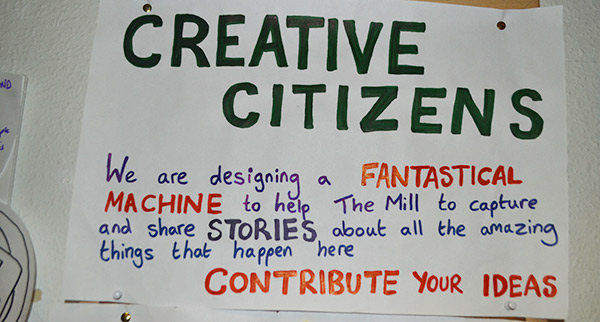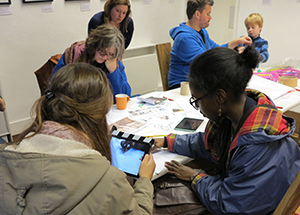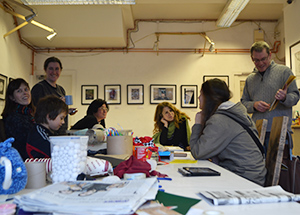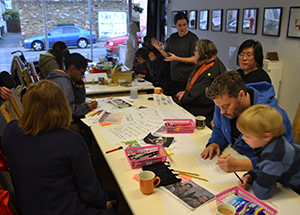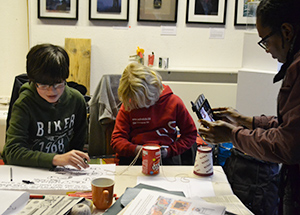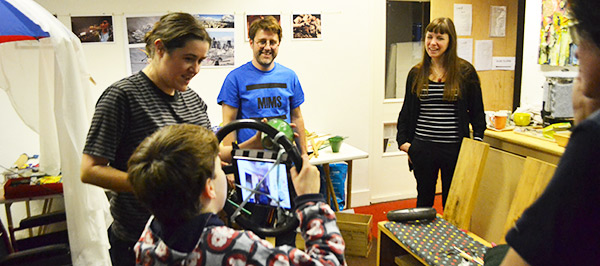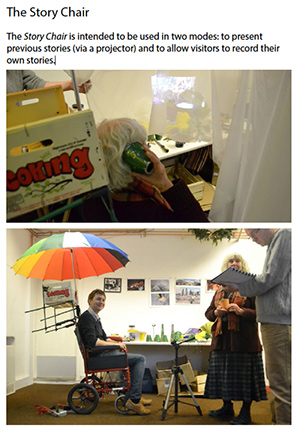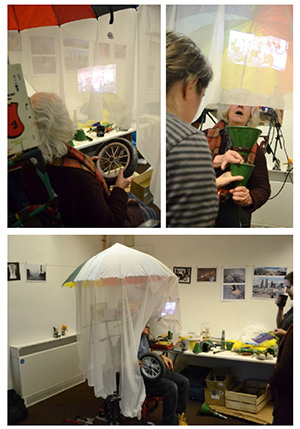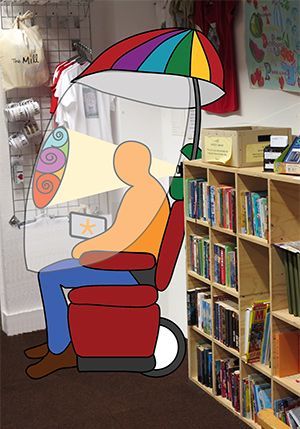Co-creation of the Story Machine
In Part 1, we discussed some of the challenges and ‘process friction’ in integrating digital storytelling into community activities, and introduced our initial work with The Mill, a community centre in Walthamstow, east London, which provides space and resources for local creative citizens to organise groups, events and activities. The next stage in our engagement with The Mill was understanding how storytelling could best be incorporated into the everyday running of the centre–the groups, events and activities that form the centre’s work.
Through autumn-winter 2013, some of the RCA team–Alan Outten, Lizzie Raby and Dan Lockton (myself) ran co-creation workshops with The Mill community (mostly active volunteers and visitors, young and old), together with Michelle Reader, a local Walthamstow artist whose sculptures and family workshops recycling scrap materials into animals and figures are been an important part of The Mill’s ambience. The workshops centred around the idea of a ‘Story Machine’, which at this stage was loosely defined as some kind of ‘system’ for capturing and sharing “stories about all the amazing things that happen” at The Mill.
Initial questions included more divergent creative ones (e.g. whether the ‘machine’ should be one thing or several linked things, and whether it could be ‘enhanced’ over time through art and craft activities at The Mill), questions around reducing friction and increasing inclusivity and accessibility (how to make it so as many visitors as possible would be able to use it) and more practical questions relevant to the running of the centre (where the would machine live at The Mill, what security arrangements would be needed for it, how easy it would be to move, etc). We were conscious throughout of the need for the Story Machine to integrate with The Mill’s online presence–for the outputs to be directed to the website and social media in a useful way–but also of the possibilities of ‘lower-tech’ uses for the Story Machine that didn’t entirely rely on this integration.
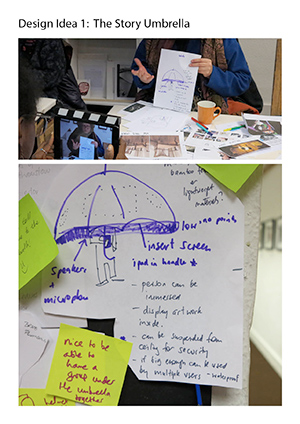
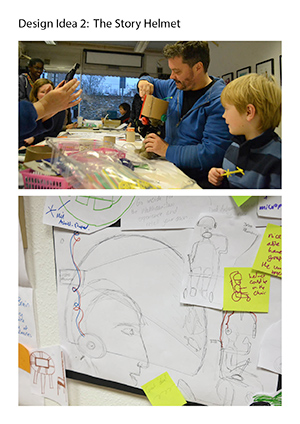
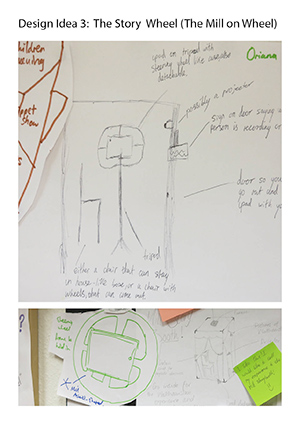
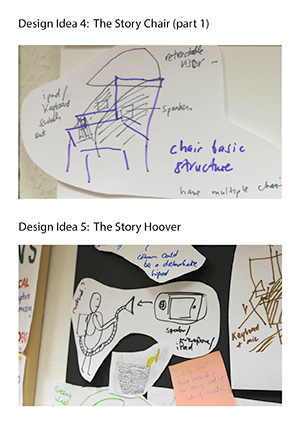
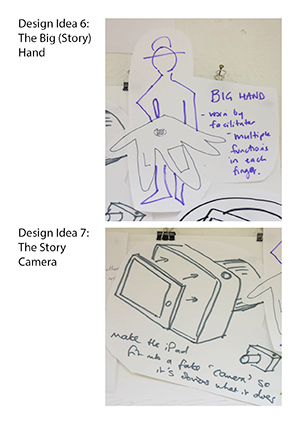
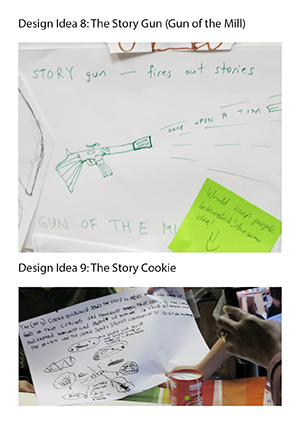
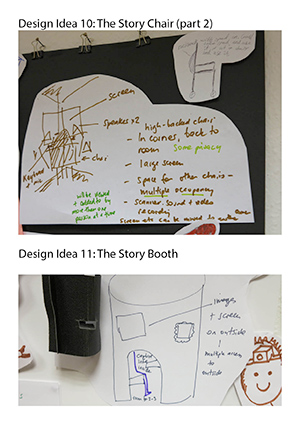
We started with some ideas that had arisen from discussions with The Mill’s staff, including a ‘cabinet of curiosities‘ concept, a ‘cuckoo clock’ that took photos at regular intervals, and a mobile mini-cinema. But it was the ideas generated by the workshop participants–the creative citizens–which moved things forward (they also took turns using the iPad mini to video each other describing their ideas, getting a sense of how it worked).
By the end of the first workshop, we had a wall of people’s drawings and ideas, including concepts such as a Story Umbrella, Story Helmet, Story Wheel, Story Booth and two kinds of Story Chair.
Visitors to The Mill continued to comment on and annotate the drawings over the next couple of weeks, including suggestions as to what sorts of things they might like to tell stories about, ranging from activities at The Mill, to local characters and points of interest around Walthamstow itself.
In a second, more practically focused workshop, another group of The Mill community members and staff, along with Michelle Reader and the RCA team, took forward elements of ideas from the first workshop, combining an array of materials (many of them scrap or second-hand, brought by Michelle) and technology (a projector, an iPad, Nexus tablet, and a digital camcorder) to embody some of the concepts. The use of the iPad, as also used in the Midsomer Murder at The Mill film earlier in the summer, was primarily to reduce the friction of online sharing, enabling direct, easy integration with a whole range of possible social media services and other services including cloud-based backup. The large screen (compared with a camcorder) also introduced a social element to filming, as multiple people could be ‘behind the camera’ at once.
Through iterations of very rough prototyping, and trying things out with people present (including people visiting the centre to take part in other activities), we explored two main concepts–the Story Chair idea (including elements of the Story Umbrella and Story Booth) and the Story Wheel (including elements of the Story Hoover). Ideas and criteria we considered included: making it fun and engaging for both those “filming” and “being filmed”; encouraging people to “talk to the machine[s]”; whether the machine could take on the role of a tour guide for The Mill; allowing people to “revisit” previous exhibitions/events; making it easy to record and “upload” content; and a “recycled” aesthetic with additional knitted/craft covers, etc.
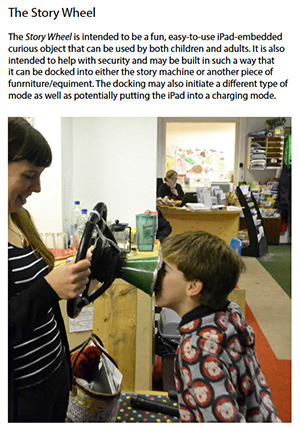
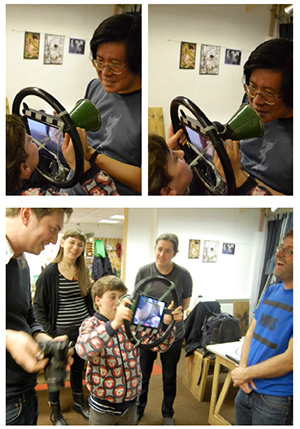
Using The Mill’s iPad tied in place in the middle of an old Reliant steering wheel, with a metal flower-arranging cone fixed in the centre, the prototype Story Wheel proved to be an engaging way of making the iPad into a ‘curious object’ to inspire and provoke filming interviews and stories, as well as the rim of the wheel making it easier for children and adults alike to hold the iPad steady for filming (similar to Ben Wilson‘s Mike Figgis FigRig).
The Story Chair started out as an umbrella mounted on an old Remploy transit wheelchair, with a fine curtain fabric draped over it. With a projector mounted in a vegetable crate fixed to the back, it offered the chance to sit in semi-privacy, either watching a video or image slideshow, or telling a story to the Story Wheel while holding it. Initially we weren’t sure whether the Story Chair should be somewhere someone should sit to tell a story, or experience someone else’s stories, or review previous events (or all three)–this was the kind of question that was best resolved through The Mill community itself making decisions based on its needs and intended uses.
One insight which became apparent through this process of people trying it out was that having a camcorder connected directly to the projector in real time–so that someone sitting in the chair could experience a tour of an exhibition, or see the activities and conversations going on elsewhere in The Mill at that moment–provided an unexpected but intriguing affordance, although at this point they were still connected by cable. In allowing someone in the chair to watch a projected video, but also enabling other people in the room to see (in mirror image) what was being watched, the thin fabric screen also offered an unusual opportunity to use the Story Chair in multiple ways, as a display for The Mill (more engaging than just having a monitor) but also a place to sit down and view stories and photos.
After the workshops, we considered alternative ways the Story Chair could be developed, building on various aesthetic influences, the materials and budget, and how it would fit into the space available, alongside the Story Wheel and online integration as separate-but-linked parts of the overall Story Machine.
The Story Machine building on the initial prototypes was constructed over January-February 2014, by Michelle Reader with assistance from the RCA team, and decorative touches from The Mill community. We planned it alongside the organisation of an interactive exhibition, Telling Stories. In part 3, we’ll cover the launch, and how the Story Machine has been used in practice by the community since.
